The Church and the Jews: Medieval Europe
As we follow the history of the western Church and the Jews out of the ancient
world and into the medieval world, we leave the Mediterranean sphere for the
emerging kingdoms of what will be known as Europe. We should stop for a moment
and reflect on the question of how, upon the ruins of the western Roman empire,
these kingdoms emerged.
From the fifth to eighth centuries CE, the region of Europe underwent dramatic
demographic changes as various Germanic and Hunnish peoples invaded. These peoples
intermarried with the old Roman population, creating new patterns of language
and culture. Europe north of Italy was an overwhelmingly rural society. Communications
with more developed urban areas broke down as the old system of Roman roads
and bridges fell into decay, and as, later on, Islamic domination of the Mediterranean
(including former Byzantine lands) increasingly isolated Europe from the east.
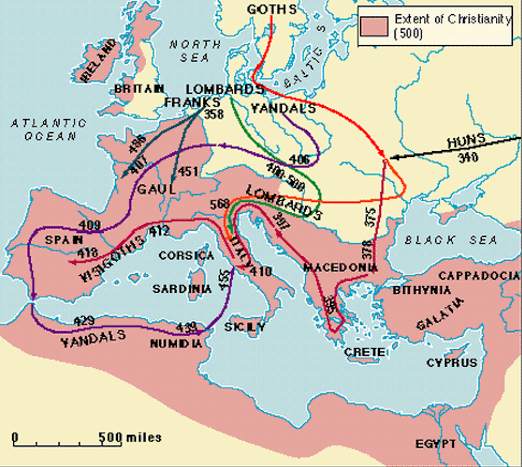
Medieval Barbarian Invasions Map
Christianity quickly gained wide acceptance in western Europe, but in forms
that lacked the sophistication of the Christianity of Late Antiquity. Christianity
lost its imperial face and became increasingly localized. The veneration of
relics and local saints became the focus of Christian piety. Monasteries provided
islands of prayer and scholarly pursuits, amid a population concerned primarily
with settling the land, establishing agriculture, clearing forests, and protecting
against marauders.
At the same time, Church organization in the west was beginning to crystallize
around the "papacy." It was in the sixth century that Rome asserted
its exclusive claim to the term
papa (pope) for its bishop. True, the emerging
papacy in Rome had only tenuous control over ecclesiastical activity in the
territories to the north. But it was defining itself in ways that were important
for the future. Of vital importance was the doctrine of
Petrine authority -
that is, the doctrine that the bishop of Rome, following in the line of St.
Peter, was the earthly head of the entire Church. Leo I (440-461) was the first
bishop of Rome to assert such authority by designating himself "vicar of
St. Peter."
By far the most important medieval pope as regards relations with the Jews was
Gregory I (590-604), an enormously influential pope in all respects. We possess
800 letters from this pope, of which over 20 deal with matters affecting Jews.
Pope Gregory I ("the Great") may be regarded as the founder of accepted
papal Jewish policy in both its positive and negative aspects. On the one hand,
he ordered that Jews should not be molested, and that they should be protected
from violence and permitted the free exercise of their religion. He expressed
disapproval of forced conversion, and was firm in allowing the Jews exactly
those privileges they enjoyed under
late Roman law. On the other hand, he held
that Jews should be restrained from exercising any semblance of authority over
Christians, or from enjoying equal status with Christians, or any privileges
beyond those guaranteed them by existing Roman law.
Gregory I also expressed openly negative views of Jews. They were full of
perfidia
(treachery) and unbelief. Only twice in his letters does he speak of Judaism
as a
religio; most often he calls it a
supersitio, one which would "pollute"
Christian faith. But most important was his basic position, summed up in a letter
to Palermo: "Just as the Jews should not have license to practice in their
synagogues anything more than is allowed them by the law, so they should not
suffer any disability in that which is conceded to them." This became the
basis of "Sicut Judaeis," a papal decree that was to be renewed generation
after generation, granting theoretical papal protection to the Jews (more on
this later). It is with Gregory I, moreover, that the papacy came to be recognized
as the supreme authority of the western church. Jews outside Rome, and even
outside Italy, began to address appeals for protection to the popes, primarily
through the mediation of the Jews of Rome.
It was only after the papacy was emancipated from the Byzantine Empire, in the
eighth century, that it began to extend its influence effectively to the new
kingdoms of Europe. In a letter written by Gregory II in 729, this pope expressed
his rejection of Byzantine authority and his contempt for the emperor in Constantinople,
and spoke proudly of his developing alliance with "the peoples of the west":
We derive our power and authority from the prince of the apostles, Peter, and
we could, if we wished, pronounce judgment on you, but you have already pronounced
judgment on yourself and on your counselors: and you and they may just as well
remain accursed...The whole occident [i.e., west] looks to us...if you wish
to test this, truly, the peoples of the west are ready.
The emerging northern kingdoms were increasingly drawn into the papal orbit.
The most powerful of these was the
kingdom of the Franks. The popes' growing
interest in this kingdom is easy to understand. While the emperor in Constantinople
openly flouted papal claims, the Frankish kings showed genuine veneration for
St. Peter and his vicar. The papacy was eventually able to emerge as a power
with a
sovereign territory by harnessing the Frankish king in the function of
"patrician of the Romans" - that is, protector and defender of Roman
church. As a result, the papacy became a dramatically more powerful force in
the development of Europe. The alliance between king and pope, however, was
fraught with potential conflict.
Carolingian Europe
By 900, the Mediterranean had fallen into deep decline. It was no longer the
unifying sea of a vast centralized empire. In fact it had become a barrier dividing
the three largely hostile worlds of Byzantium, Islam, and the west. In the west,
the political, economic and cultural center of gravity had shifted to the north,
as the north developed new lands and markets while the south suffered ecological
and climatic decline.
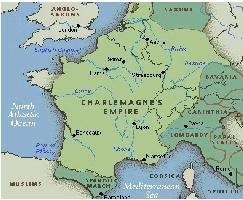
Map of Carolingian Europe
Northern Europe had also gone through a religious transformation. In the year
400 most northern Europeans worshipped one or more non-Christian gods; by 900
Christianity had reached most of the northwest, and was spreading into Scandinavia
and eastern Europe. By 900, in Gaul, Germany, Britain, and Ireland, Christianity
was enforced by the state. Baptism was, in theory, universal, and monasticism
was the most important spiritual and cultural force in Europe. Monasteries of
the Benedictine Rule were bases for missionary activity, centers for basic education
in Latin, for book production, and major economic and political centers as well.
In this new sphere, it seemed at first that the legacy of the Church Fathers
concerning the Jews was not to have much impact. It did not significantly color
the policies of the so-called "Carolingian" kings (Frankish kings
in the line of Charles Martel [714-741]). These kings were first and foremost
state-builders. In an effort to foster the economy of their dominions, and especially
to promote the much-needed importation of goods from abroad, Charlemagne (768-814)
and his son Louis the Pious (814-840) made a special effort to attract Jewish
traders, mainly from Italy, to their northern French and German possessions.
We possess only three texts of charters from this period, all issued by Louis
before 825. They offer imperial protection of life, limb and property. Jews
were allowed to own slaves and import them from abroad. Contrary to ecclesiastical
law, Jews were allowed to employ free Christians.
The Carolingian charters to the Jews laid the foundation for the legal status
of Jews in medieval France, Germany and England. They are deeply colored by
feudal concepts. In the charter addressed to Abraham of Saragossa, Louis stated
that Abraham "had entrusted himself unto Our hands, and after an oath We
have received and hold him under our protection." That is, through an oath,
Abraham assumed the character of a royal vassal. A high fine of 10 gold pounds
was to be paid to the emperor for the murder of a Jew. Jews were to be allowed
"to live quietly under Our tutelage and protection and faithfully to serve
Our court," a phrase repeated in charters to non-Jewish merchants. In this
evolving feudal relationship, the Jews' dependence on and alliance with royal
power became key factors in their destiny on Christian soil. The relationship
was based on mutual self-interest: from the emperor's point of view, trade was
stimulated, and Jews paid special taxes.
The Crusades
By the eleventh century, the idea had been planted in European society that God would reward those who fought in a holy war. Thus the ideals of chivalry merged with a deepening Christian piety. When, in November 1095, Pope Urban II preached a sermon in southern France, calling on the nobility to launch an expedition to recapture the Holy Land from the Muslim Turks, the idea was received with tremendous enthusiasm. Such an undertaking was especially attractive to the younger sons of nobles, who did not inherit land from their fathers and who experienced increasing difficulty, as settlement in Europe developed, carving out new lands for themselves. The First Crusade channeled their military training, aggressive impulses, and hopes for glory away from warfare with other Christians over land and castles, into warfare against the infidel.
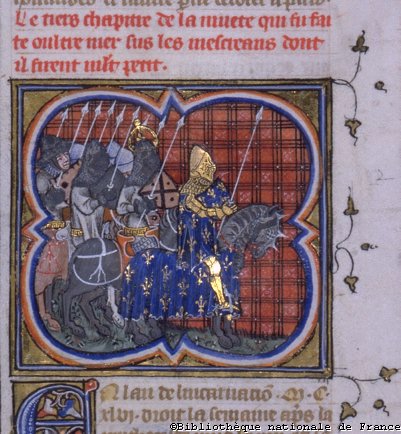
Chivalry and Piety Joined: Louis VII and Emperor Conrad III set out for the Second Crusade
Pope Urban II preached the Crusades to the nobility. But preachers in northern France and the Rhineland, inspired by the idea, triggered movements among peasants and the poor, along with some nobles and clergy. Vengeance for the blood of Jesus was a declared purpose of the Crusades in these sermons. Bands of people, aroused by such preaching, set off for the east, miserably equipped, in what is known as the Popular Crusade (an unanticipated aspect of the First Crusade). The First Crusade as a whole gave expression to a growing sense, among poor and privileged Christians alike, of belonging to a unified Christendom, mobilized against the enemies of Christ. It is no wonder, then, that as the crusaders passed through the Rhineland in 1096, they attacked the Jews living in the Rhineland towns – among other places, in Speyer, where only six years before the emperor had renewed the
charter granted by Bishop Rudiger in 1084.
Some scholars view the crusader attacks in 1096 as a turning point in Jewish-Christian relations in Europe. In popular thinking – quite apart from what learned churchmen taught – violence against the Jews could be justified as an act of piety. From the Jews’ point of view, the fragile sense of security they had come to expect was destroyed: The charters that had promised protection had proved ineffective in the face of popular fury.
Other factors were also at work, gradually undermining the status of the Jews in Christian towns. These towns were changing. In the early Middle Ages towns had served mainly as administrative centers where a bishop (or, occasionally, count) lived in a fortified complex that included a church. The surrounding rural population would flee there under attack. But as the population and economy grew, peasants from the countryside migrated to towns, where they might become artisans, shopkeepers, or servants. To some degree the Crusades themselves impacted on the growth of towns. (The Crusades continued, in successive waves, into the thirteenth century and beyond.) They stimulated a wider demand for the luxury goods that the crusaders found in such easy supply in the east. The Crusades, along with the increased demand for eastern goods, also encouraged the development of better means of communications and transport between Europe and the east. The Jews were no longer the only (or primary) intermediaries.
The Growth of the Papacy
The First Crusade, preached by Pope Urban II in southern France, is only one reflection of the growing influence of the papacy in western Europe. Far-reaching reforms of the Church had already been introduced by Pope Leo IX (1049-1054) Pope Gregory VII (1073-1085). These were aimed not only at reforming what had become a corrupt and worldly papacy, but at extending the power of the papacy and building a consistent plan of government, through papal legates, councils, and a vastly increased written correspondence. This work was carried on by successive popes, creating a huge papal bureaucracy whose work covered a great array of activities, judicial, diplomatic, political, and, of course, ecclesiastical. As one scholar put it, “After about 1150, the popes were the busiest men in Europe.” An impressive achievement of the Church in the twelfth century was the codification and dissemination of the Church’s canon law, an undertaking that was inspired in part by the teaching of Roman law at a new type of school in European urban centers – schools that would evolve into the modern university (more on this later).
The papacy reached the height of its power under
Innocent III (1198-1216). It was under this advocate of papal supremacy that the old title of the pope, “vicar [i.e., deputy] of St. Peter,” was replaced by “vicar of Christ.” As he put it, “We are the successor of the Prince of the Apostles [Peter], but we are not his vicar, nor the vicar of any man or Apostle, but the vicar of Jesus Christ himself.”
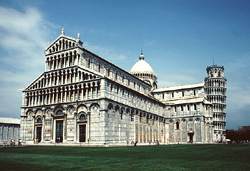
13th century cathedral in Pisa, reflecting the new wealth of the towns - and the Church
Innocent’s main contribution to the development of Catholic doctrine and practice was his convening of the Fourth Lateran Council in 1215. This council produced the definitive list of seven sacraments. It also introduced the doctrine of
transubstantiation, a term for the mystical transformation of the communion wafer and wine into the actual body and blood of Christ (in substance, not form). This was to have unanticipated repercussions for the Jews. More immediately significant for the Jews was the Fourth Lateran Council’s ruling that Jews must distinguish themselves from Christians by wearing an identifying
badge.
Innocent III also played a key role in the establishment of the
mendicant orders, that is, the Dominicans and Franciscans (about whom more later). His motive for founding these orders was to harness the religious fervor of their members to fight Christian
heresies that had become powerful in thirteenth-century Europe. Eventually, however, the militant members of these orders, trained in oratory and religious disputation, were to become aggressive agents of the Church in efforts to convert the Jews.
Changing Conditions of Town Life
A century and a half after the Bishop of Speyer granted a charter to the Jews (1084), the towns of Europe were being transformed. True, many of them were little more than overgrown villages, surrounded by a wall. (Few had more than 40,000 inhabitants.) But if the town was located advantageously (at an important bridge over a river, for example), it would tend to grow; and the lord, eager for tax revenues, would encourage its growth. What would come to distinguish a town (or “city”) from a village would be its occupational composition: it would have enough people specializing in trade and crafts to overshadow the agricultural interests of the old community.
Gradually, a struggle developed throughout Europe between the lords and the townspeople, who sought to free themselves from their obligations to the lord. Sometimes there was violence, but generally the townspeople bought their “liberties” or “privileges” from the lord, one by one. The town would buy the right, for example, to pay a yearly lump sum to the lord, rather than have the lord’s bailiff go from door to door collecting taxes; this reduced the lord’s intervention in the life of the town considerably. Then the townspeople might gain control of commerce by buying the right to establish a merchants’ guild. The town might then buy the right to its own municipal court. In this way, the townspeople gained a high degree of freedom from ecclesiastical and aristocratic (or monarchic) control. As the saying went, “Town air makes free.”
Town air did not, of course, make everyone free. A wealthy oligarchy of urban property owners (burghers) tended to develop, with an agenda of its own. The growing power and organization of these burghers had dangerous consequences for the Jews. First, the establishment of merchants’ guilds, which excluded non-Christians, drove the Jews out of the occupation that had originally brought them to Europe. (These guilds were followed in the thirteenth century by craft guilds, which eliminated the possibility of Jews’ working in most craft occupations.) But the increasing need for credit in an expanding economy offered Jews an alternative way to make a living using the capital they had accumulated, namely
money lending – an occupation they were permitted to engage in because it was forbidden to Christians. Some Jewish money lenders became wealthy (a few became enormously wealthy), while others engaged in very small-scale lending (pawn-broking). But all of them, rich or poor, were despised.
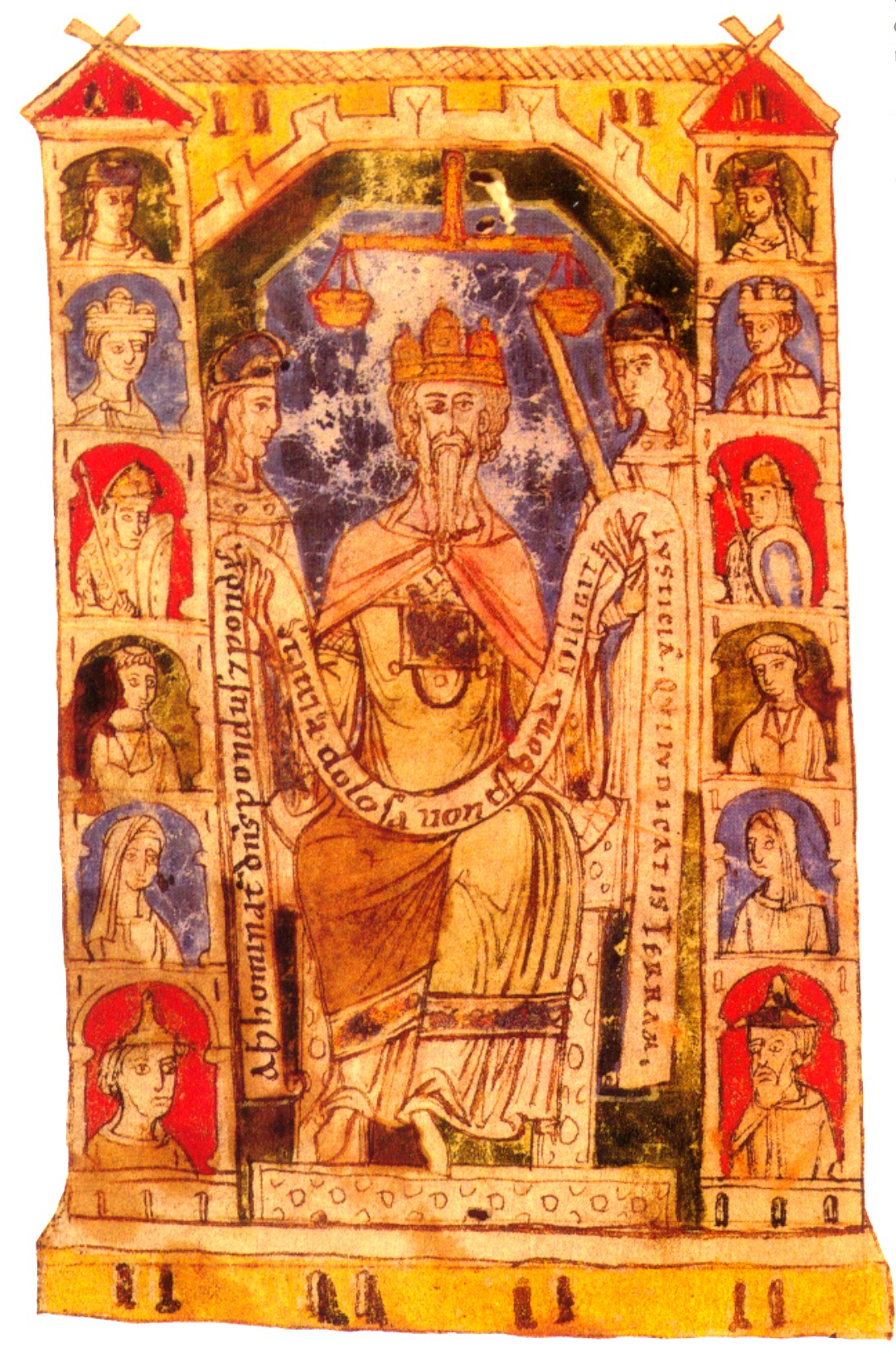
A twelfth-century German depiction of the medieval social hierarchy, with Jews, in the spiked hat they were required to wear to distinguish themselves from Christians, at the bottom.
The fact that a religio-ethnic minority was increasingly excluded from commerce as European towns developed was a rather “natural” development, with parallels in many other contexts. Church policy would seem to have had very little to do with it (except insofar as the Church sought to prevent Christians from lending on interest). But a new religious ethos was developing in towns, one that dovetailed with the socio-economic hostility to the Jews of the new burgher class, and to some degree arose from its ranks.
The Mendicant Friars and the Jews
Up to the twelfth century, the monastery was the focus of religious life in a largely rural Europe. These institutions were inspired by the powerful ascetic ideal of fleeing the world in order to dedicate one’s life to prayer. But the monastery was also an agricultural estate on which monks lived and worked, closely bound up with the rural cycle of life.
The monastic movement has its roots in a very early period of Christianity, and had as its focal impulse the aim of getting away from world, with its material and otherwise corrupting distractions. But medieval monasteries were closely interlocked with the feudal system. The abbots were nobles, tied closely to their families, and they managed their estates somewhat in the manner of lords. Many noble families founded monasteries, to have the benefit of the monks’ prayers, to send some of their sons there to take up the monastic life, and to bury their dead there. Fittingly, it was in this feudal and monastic era that the position in which the vassal paid homage – kneeling, bareheaded, hands clasped – became the posture of prayer.
Prayer, of course, was the key activity that took place in monasteries. The monks prayed not only for their own souls, but for those of their founders and benefactors. They prayed for the welfare of their local societies in general. Monasteries were also centers of book making and book preservation. But the “monkish” relationship to books tended to be reverential rather than scholarly. Reading books belonged to the cycle of the day’s devotions and offered a different sort of connection to (not understanding of) the divine. Critical thinking was not, in general, part of the monastic enterprise.
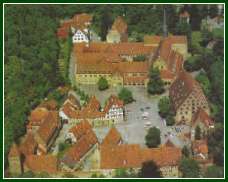
Cistercian abbey, Maulbronn, Germany, built in the 12th and 13th centuries.
As town life developed in the twelfth and thirteenth centuries, with its innovations and its trade connections to faraway places, as well as its
Gothic cathedrals, new questions were raised about many things, including the Church’s monopoly on spiritual life. Increasingly, lay people expressed dissatisfaction with a clergy that seemed to be composed of obtuse monks, wealthy abbots and bishops, and morally compromised priests.
The Church could not ignore attacks on the very foundations of its authority by large numbers of lay Christians. The two major movements that it declared to be
heresies, and sought to suppress – the Waldensians and Albigensians - both denounced the Catholic clergy, their wealth, and the sacraments they administered. It is interesting that the leader of the Waldensians, Peter Waldo, had been a wealthy merchant in Lyons before he adopted a life of poverty and began preaching around 1170.
It is also interesting that the Church’s “answer” to the discontent came from two spiritual leaders who in many ways
shared that discontent. In about 1205, a Castilian priest named Dominic began preaching among the Albigensians, seeking to bring them back to the faith; he insisted that his followers, sent out to preach the true doctrine, live in poverty and support themselves by begging. The Dominican Order (the Order of Friar Preachers) was founded in 1216. The second movement had less likely origins. Its founder, Francis of Assisi, was a pleasure-loving son of a wealthy merchant. But he experienced a conversion not unlike that of Peter Waldo and adopted a life of poverty. Pope Innocent III was astute enough, however, to recognize his potential
value within the Church. In 1209 he came to a verbal understanding with Francis, granting approval for a new order under Francis’s leadership, the Order of Friars Minor, known as the Franciscans. Members of these two mendicant orders (from the Latin
mendicare, to beg) were known as friars rather than monks, because they were to lead their lives not in seclusion, but in active contact with laymen. Both orders grew rapidly, and were soon serving major roles in every activity of the Church.
Members of the Dominican Order, in order to evangelize effectively, were expected to be learned in theology. They were trained at
universities – relatively new institutions on the townscapes of Europe, that by about the early twelfth century had eclipsed the monasteries as centers of learning. Given the Dominican emphasis on learning, it is not surprising that some of the greatest of medieval European thinkers were Dominicans - Albertus Magnus and Thomas Aquinas among them. The Franciscans were quick to follow suit, and soon both Dominicans and Franciscans occupied important university chairs throughout Europe.
Armed with rationalist philosophy, papal support, and great missionizing energy, the mendicant friars became the voice of the Church in the late medieval period – for better or for worse. Although Dominic began his career preaching to the Albigensians, once the
papal Inquisition was established by the Fourth Lateran Council in 1215, his followers the Dominicans began to play a leading role as inquisitors, interrogating and punishing them. (For this reason some people took to calling them
domini canes – “watchdogs of the Lord,” in Latin.) As such, it is not surprising that they soon cast their eyes on those unbaptized unbelievers of urban Europe, the Jews. Before long the mendicants saw the Jews as targets of their missionizing, taking steps (usually authorized by the pope) that rendered the routine protections of “Sicut Judeis” meaningless.
Jews were also more vulnerable to Christian preaching as the world of Christian learning gained sophistication and subtlety. It was very difficult psychologically to cross religio-ethnic boundaries in the medieval period, but there were Jews who were attracted to the
new intellectualism of the Church, as well as to the advantages that baptism offered materially. These converts provided churchmen with new insight into the Jewish world, as well as new confidence in their powers to bring about a conversion of the Jews.
Jewish converts could, above all, read the Hebrew texts that provided the basis for Jewish existence. It was through educated converts from Judaism that the learned Christian world became aware of post-biblical Judaism and its central text, the Talmud. This provided two new (and rather contradictory) lines of attack against Judaism:
a) The Talmud was a corruption of the “true” Judaism of the Old Testament. Contemporary Jews were thus no longer witnesses to the truth of Scripture: on the contrary, they were
corrupters of the truth of Scripture, and had no place in Christendom. This line of attack resulted, among other things, in the
public burning of the Talmud.
b) The Talmud actually contained explicit hints of the truth of Christianity. If Jews could be persuaded of this, if they could be convinced that their rabbis had obscured the true meaning of the Talmud, they could be brought to Christianity. This line of attack was adopted in public disputations with Jews - most famously in the disputation of friar Pablo Christiani (a convert from Judaism who was a Dominican after his conversion) with one of the most prominent rabbis of the thirteenth century, Moses ben Nachman (also known as “Nachmanides”). (See
Disputation of Barcelona)
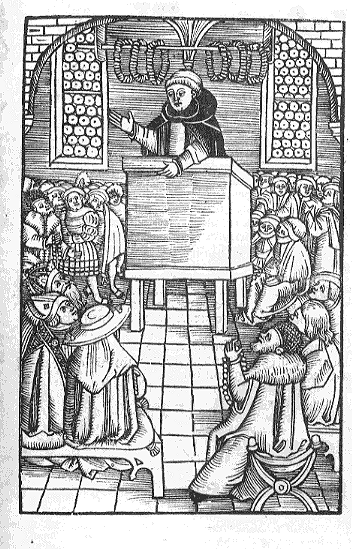
Woodcut of Dominican friar preaching, Leipzig, 1515.
Fiery preaching became the hallmark of both Dominicans and Franciscans. The Dominicans were in the forefront of an effort to compel Jews to listen to conversionary sermons. Such forced sermons became widespread in the thirteenth century, violating the traditional boundaries that protected Jewish practice and worship. Dominicans and Franciscans also preached inflammatory sermons against the Jews to Christian audiences. Such preaching had both immediate and long-term results. In northern Italy the preaching of the Franciscan Bernardino de Feltre led directly to the
Trent blood libel trial of 1475. Elsewhere such preaching prepared the ground for anti-Jewish violence and the eventual expulsion of the Jews.
The Demonization of the Jew
The preaching of the mendicant friars was one of the major factors that led to a widespread change in the popular perception of the Jew in the late medieval period. In European society the Jew had long been viewed as erroneous, depraved, and guilty of deicide. He was not, however, widely seen as threatening the very existence of Christian society. But in the later Middle Ages the Jews became closely associated in the Christian mind with the devil and his supernatural powers. Increasingly, Christians came to believe fantastic stories that Jews were secretly perpetrating vicious and bloody crimes.
To be sure, the association of Jew with devil had ancient roots. In the Gospel of John, Jesus is presented as addressing the Jews as being “of your father the devil” (John 8:42-44). In the Book of Revelation, Jews who resisted Christian teaching were referred to as being “of the synagogue of Satan” (Revelation 2:9 and 3:9). But the idea became widespread in popular thinking only later. When Shakespeare put into the mouth of a character the words, "Certainly the Jew is the very devil incarnal!" he was drawing on an idea that would have been understood by everyone in his sixteenth-century audience (
Merchant of Venice II, ii, 27).
It is important to understand that in the medieval mind, the devil was a very real figure, though it could act in different guises. The “devilishness” of the Jews was expressed in a variety of ways, always fantastic and often grotesque.
The Jews’ dangerous supernatural powers were believed to coexist with sub-human (or at least freakish) physical characteristics. They were believed to have horns, or tails, or a goat’s beard - all tokens of their Satanism. (The billy goat was considered the devil’s animal, a symbol of sexual excess.) Jews were said to have a special odor - the
foetor judaicus – which was a punishment for their crime against Jesus. (It was believed they lost this odor when baptized.) Jewish males were believed to menstruate – again, symbolic of the blood of Christ they were accused of shedding.
They were accused of poisoning wells, of ritual murder, of the blood libel, and of the desecration of the host (all discussed in
Late Medieval Persecutions). They were also believed to be in league with the Antichrist – a mythical figure that is mentioned as early as the tenth century, but that became popular only in the late Middle Ages. It was widely believed that Christendom faced an imminent war with this “Antichrist” (the name is self-explanatory) leading the forces of Satan. In the end, Christ and the forces of good would be victorious, but only after great destruction. Even leading scholars like Thomas Aquinas and Albertus Magnus discussed the Antichrist, stating, for example, that he would be born in Babylon, of the tribe of Dan, and would proceed to Jerusalem, where he would be circumcised and would proclaim himself the Jews' messiah. The Jews, of course, would flock to this creature, who in the popular imagination was believed to be born of a devil and a Jewish harlot - in diametrical contrast to the Son of God, born of a virgin.
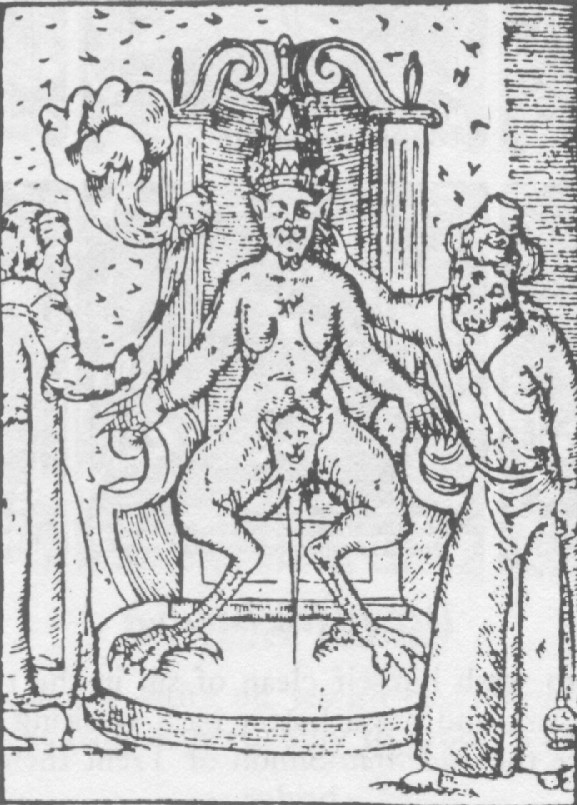
Satan Attended by Jews, Paris, 1575.
Such an atmosphere of paranoia about the Jews led to an increasing belief that Jews should be removed from Christian soil. Efforts to expel them became common everywhere, and were often successful. Jews had already been expelled from England (1290) and France (in stages, during the fourteenth century). Expulsions of the Jews in Christian Europe peaked around 1500, instigated mainly by the townspeople and friars. Between 1492 and 1520, the Jews were expelled from Spain, Portugal, Provence, Sicily, and many towns and regions of the Holy Roman Empire and Italy. (The papacy, let it be said, dissociated itself from these expulsions, and even sought to protect the Jews in the Papal States - which became a haven for some of the exiles.) Violence against the remaining Jews became more common.
Thus, by the early sixteenth century, the Augustinian notion of tolerating the Jews in a subordinate and humbled status had been replaced with a basic popular religious attitude of non-toleration.







